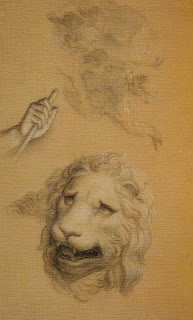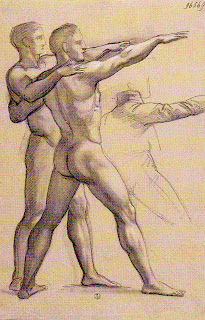The special word art is a sacred
temple, a mysterious inner sanctum of artistic pursuit, where magical
intellectual powers interact with primordial outpourings of the irrational subconscious.
Paraphrasing Thucydides, who has put it abruptly: When common, everyday words
lose their definitions and meanings, there is a general crisis in a given
field.
To go further, when art terminology
has lost its power to convey sense, idea, or meaning of art expression, then
the artist, the art field, the whole cultural endeavor, is conflicted, confused,
and disordered; it becomes a chaotic wasteland, a lost continent of the
culture.
The net result has been to let loose
a carnival of art dilettantism and chi-chi art sophistication concealed behind
an imposing front of synthetic rhetoric, aesthetic lyricism, and emotional
bathos. The state of art today is such that it can now be performed by tyros and
amateurs with virtually no study, preparation, or training. In galleries and
exhibitions, the amateur aesthete can now compete on equal terms with the
seasoned, knowledgeable master with such facility that hardly anyone,
frequently not even art connoisseurs and critics, can tell good art from bad art,
amateur art from professional art. When the quest for brevity and simplicity
has been reduced to infantile primitivism, we have lost the validity of concepts;
when the creative urge to reveal life has been distorted into a wayward surge
of undirected energy, we have lost control of direction and experimentation;
when the search for clarity and order has been diverted to piecing out a
meaningless jargon of amateur misbehaviour, we have lost our artistic heritage;
when the need for definitions, standards, and criteria has been seduced by
vacuous emotional mumblings, we have seen the perversion of the philosophy of
art and aesthetics. When the artist has surrendered his status, his authority,
his principles, his professionalism, then the amateur has taken over, and the jungle
is upon us.
The problem of the amateur in art is
really the problem of the artist in society.
To say that the amateur has invaded
the arts, and that the fine arts are becoming an amateur art, is to say that
the artist has defaulted in his obligation to the social environment.
But this view alone does not face
the issue squarely, for it would force the conclusion that the artist alone is
responsible for the neglect and deterioration of art. To say that the artist has
rejected the norms of living, has removed himself from society, has turned away
from reality to promote his inner personal image of life and art-for-art's-sake
isolationism, is to say the exile prefers the desert, the suicide enjoys
cutting his veins, the tortured man relishes his anguished cries for help. In
truth, these are but the pathetic attempts of the withered, truncated man to
become a whole man. The issue at hand is really a dual problem; it is not only
the artist's inbreeding and involution-it is also society's forced estrangement
and neglect of the artist. If there is a crisis in art, a disintegration of its
moral fiber, a decay of its historical precepts and philosophical virtues, it
is because society first has disavowed and disabled it as an intellectual
resource, a cultural necessity, a social and educative force. It has refused
its permission to be integrated with the technological, scientific advances in
our time, except as a utilitarian, commercial, ancillary art. To engage a
solution on this basis needs a moral reawakening of society and a conceptual
reworking of art.
The reestablishment of self-control
in the artist and social respect for art devolves on creating again a new
dualism of art and science in the twentieth century. The obscure terminology
must be clarified and attached to commonly shared associations; personal values
must be defined according to generalized experience; the personal subjective purpose
must be widened to embrace the broader social goal. The immediate and urgent necessity,
the first order of the day, is to redefine the old word art. The clichés, the nonsense, must be stripped off. Art must have
a new interpretation, infused with new meanings and values, in order to find
its equal place with other positive cultural pursuits in our time. It must mean
as much to the population as medicine, surgery, bacteriology or physics,
engineering, architecture-or steak, mashed potatoes, apple pie. It must be executed
so ably and understood so well that it will stand strong and firm as a
skyscraper
does when it is done well-or it will
collapse in ruins when it is not. Art must be refined into a critical
intellectual tool to meet these challenges. New cutting edges must be given to
the old "saw," fine-honed and sharp, diamond-hard and tough , to
stand up under the friction and abrasion of life. To be "art," it
should be made responsible for communication of its ideas and concepts; it
should reflect the life and times of the artist, his integrity, his ethics, his
democratic ideals in the progress of man; it should show his developed skill
and judgment in projecting significant, expressive form; it should reveal
invention and originality in transmitting the aesthetic experience; and, above
all , it should arise out of the environment, the social-human-scientific
culture base as the controlling factor in its creation.
This does not mean that strictures
or rigid conventions must be placed on the artist; nor does it say that
experimentation or freedom in personal expression should be curtailed or
abrogated; nor does it propose that there is only one way of seeing the world around
us, one outlook, one style or method of approach. It does not ask the artist to
obey or be subservient to any fixed rule, regulation, dogma, or tradition. It
does not set up absolutes of authority, or impose conditioned reflexes of
conformism. However, it does ask the artist to respect and rely on the positive
norms, values, and traditions that still operate and still function in the
study and preparation of the artist, that still apply in the cultural background
of modern art creation. These should be seen as the educative resource, the imperative
precondition for the survival and growth of art.
Socrates, we are told, attempting to
probe into the nature of law, speaks of the laws of men as a response to the
social pressures that arise out of human conditions in the natural environment.
And therefore, he argues with penetrating insight, to understand the nature of
law we must first understand the law of nature. The liberating principle of art
lies precisely here, in the Socratic approach to the conjoined relationship of two
mutually attracted, interacting forces-man and nature, nature and man. This
synergistic principle, if we can refer to it as such, argues for a relationship
of ideas, in Toynbee's words, in a context of challenge and response, response
and challenge. It seizes upon diverse attitudes of thought, probing for
intrinsic attributes of contraction and expansion, refinement and extension; it
enlarges the field of intellectual vision, and refines the area of critical
judgment; it tends to limit subjective bias and mental myopia.
If we apply the principle to one of
the central problems of art, the presence of the amateur in the fine arts, we
might uncover these provocative correlations: To understand the amateur of art,
we must first understand the art of the amateur; to recognize the professional
of art, we must recognize the art of the professional; to explain the presence of
the amateur in professional art, we must explain the presence of the
professional in amateur art. Suddenly, the critical questions rise to the
surface: In how many ways is professional art an amateur art? Can professional
art be easily imitated by the amateur?
The way is open for other
challenging assertions. For instance, that much-abused old habit, skill: To
discover the skill in art, let us first discover the art in skill. Or: To ask
where the old traditions are in modern art, we must first ask where the modern
is in the old art. This is not a mere game of idea inversions or word juggling.
If it were, the new statement of ideas in reverse would not be so sticky with
uneasy, astringent meanings that quickly leap to mind. Nor is this a conclusive
demonstration posed as an answer to the problems of art. It is an exercise of
reason, an analytical approach in the examination of hitherto unassailable
notions. It might be seen as the first incision in cliché and slogan surgery to
arrest the deterioration in art.
A new dualism of art and science, if
we can agree on the premise as indispensable to art today (as it was in the
Renaissance), must again seek to introduce commonly understood criteria and
standards. We must re-establish certain major links with the past as historical
background, consistent with art progress today. We must incorporate the old traditions
that are still viable, still alive today. But which are the living traditions
and how can we be sure? Let us apply the synergistic principle and make an
incision.
Our civilization is predominantly an
advanced technical age of science. It developed its abundant greatness from
earlier civilizations and beginnings. Now, a question: Where do the earlier
civilizations appear in the modern age of science? We must first ask, where
does the modern age of science appear in earlier civilizations? The answer
seems clear: in those civilizations that have made scientific contributions.
The reason we search out the older civilizations, and attach their findings to
ours, is a scientific reason. This is true historically for our humanist-democratic
institutions as well.
Therefore, the answer to the older
traditions in modern art lies in the context of the larger framework; those old
art traditions that tend to live on have survived for a humanist-democratic scientific
reason.
Where modern art has precisely been
interested in the art of the world's cultures, across the seas and in the past,
is the human reason, the scientific reason. But it has done this willy-nilly,
capriciously, driven by impulse rather than direction. It has chosen, through
uncritical acceptance of the nineteenth-century artists' hostility and rage
against the anti-libertarian French Academy
Because this polemic underscores the
need to return to rational definitions of the entire nomenclature of art and
the reworking of substantive new standards, the return of the human anatomical
figure to the lexicon of art is a major condition toward the establishment of a
new dualism of art and science. The premise of the human figure does not propose
a restatement of medical anatomy. To rediscover Vesalius is no
twentieth-century triumph; Vesalian anatomy must be given back to Vesalius. An
advance in anatomy for art must be made in artistic anatomy. Muscle and bone
structure must be left off where they inhibit or destroy understanding of
surface form, artistic and expressive form. The anatomical figure of art must
make a contribution to the dynamics of the living figure, of interrelationship
of masses in motion, of insights into the figure to be used by artists and students
of art, not medical students and surgeons. Because life today is so complex and
varied, multiplying its dimensions with every passing day, the sincere,
creative artist must be quick to react with keen insight and increased
awareness to the changing profile of contemporary life. Because he must show
versatility, flexibility, and diversification in experimental behavior, he must
base himself securely on the human root, the warm kinship of his scientific
brother, the consanguine association with the larger social environment.


































